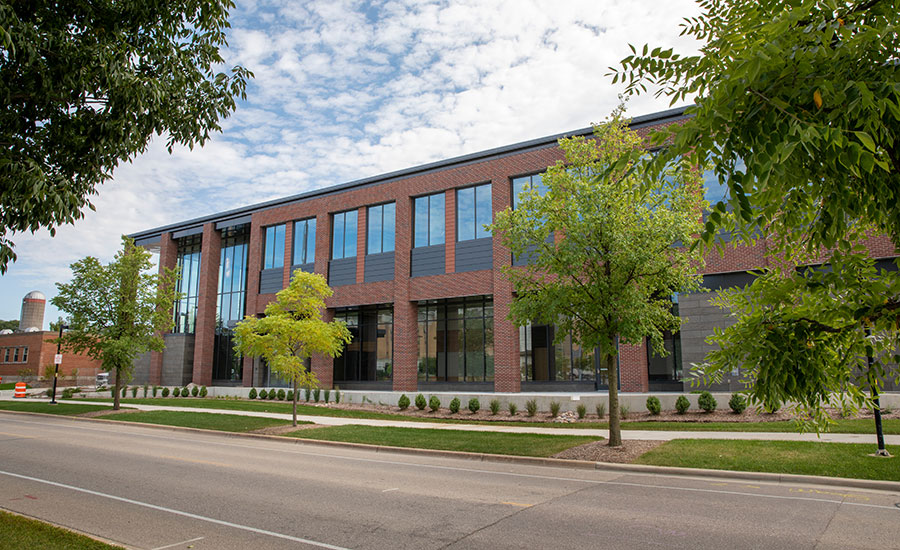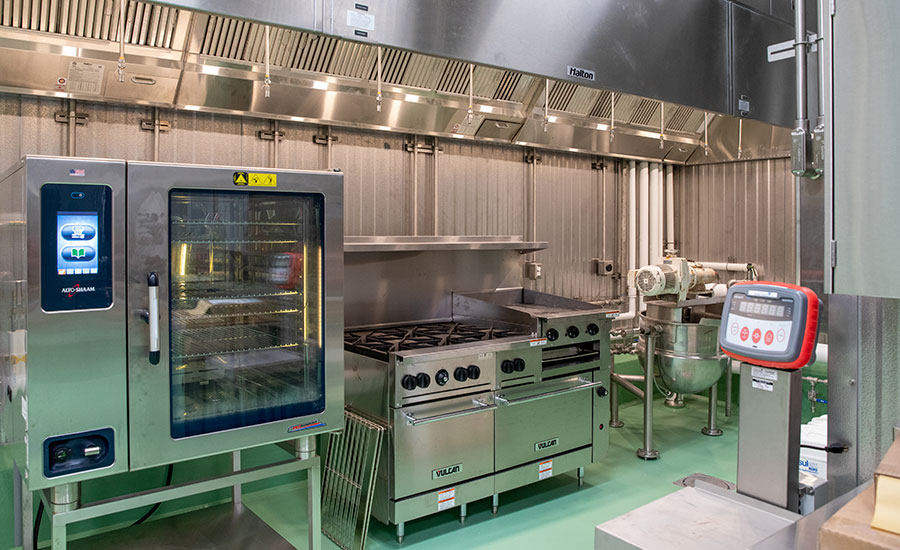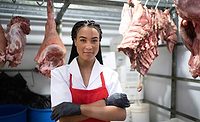Training the Next Generation of Meat Scientists
A look at the Meat Science & Animal Biologics Discovery food safety program at the University of Wisconsin

Food safety in animal protein processing remains an ongoing concern. However, rapid advances have been made in the detection of foodborne pathogens as well as in control measures. Detection methods that are faster and more sensitive are constantly being developed and implemented in commercial processing-plant operations. Equally important, prevention measures such as vaccines, probiotics, and prebiotics have been examined for use in live animal production to support optimal gut health and limit the establishment of foodborne pathogens in the gut. A battery of antimicrobials have been introduced to decrease foodborne pathogen loads in meat processing and extend the shelf life of various meat products. While significant progress has been made, much of the research on the food safety of meat has been conducted somewhat piecemeal. Outcomes of studies have relied on the capabilities of individual research facilities. Ideally, to get an accurate picture of tracking pathogens and preharvest and postharvest control measures, integrated longitudinal studies that allow the introduction of marker foodborne strains throughout the production chain are needed. The ability to track foodborne pathogens and quantitate pathogen responses throughout the meat production chain can provide baseline data for evaluating the efficacy of intervention measures. However, research facilities are often limited by possessing only certain components of the meat production chain, such as live animal housing but minimal or no processing capacity or, conversely, processing facilities but minimal live animal capabilities.
Until now….

Meat Research and Biologics – A New Era
In the fall of 2020, the new Meat Science & Animal Biologics Discovery (MSABD) building at the University of Wisconsin–Madison opened its doors for research, education, Extension, and discovery. The opening represented the completion of a $57 million building project with a total of over 67,000 square feet for advanced meat processing technologies, food safety research, and muscle/biologics biochemistry. The facilities housed in the building are state of the art, and the building consists essentially of two parts, one dedicated to meat processing of all types of animals while the other consists of a food safety laboratory and pilot plant. The meat processing facility houses a U.S. Department of Agriculture (USDA)-inspected processing facility covering over 25,000 square feet. Several features stand out in the federally inspected processing facilities. In addition to traditional carcass air chilling, both advanced air chilling and ultrachilling of carcasses can be accomplished. This facility possesses a commercial CO2 stun pit system to conduct research associated with harvesting swine and sheep. Finally, the USDA facilities are equipped with a fully functional laboratory to conduct conventional meat research.
But that is not all—the MSABD facilities are designed to think beyond conventional meat processing and generation of meat products. A unique focus of the laboratory facilities is the capability of harvesting meat coproducts that can be studied for potential nonmeat applications. This represents the biologics component of the MSABD program and offers an entirely different direction for discovery for meat and muscle biology. Meat-based biologics already has a rich historical tradition at Wisconsin–Madison, so this is not a new concept. But this research philosophy is now being carried to new heights by the faculty and students in the MSABD building. Researchers in the MSABD program can use the advanced laboratory facilities to identify and further characterize biologic materials from meat and animal tissues. These materials can lead to the discovery of unique biologically active compounds and subsequent isolation of potentially high-value bioactive molecules for use in the pharmaceutical industry as well as animal agriculture applications.

Food Safety Research – MSABD
The food safety pilot plant facilities and adjoining food safety laboratory have approximately 8,500 square feet of laboratory space with biosafety level 2 (BSL2)-containment capabilities. As would be expected, the facilities contain a microbiology laboratory for handling all aspects of foodborne pathogen research, including most of the primary foodborne disease microorganisms that pose a BSL2 public health threat such as Campylobacter, Listeria monocytogenes, Salmonella, pathogenic Escherichia coli, Clostridium perfringens, Staphylococcus aureus, and Bacillus cereus. This biosafety laboratory accommodates all conventional microbiological methods needed for the isolation, culturing, incubation, and plating of these pathogens. There is also specialized equipment for culturing microorganisms, such as Campylobacter, that have precise gas headspace requirements for optimal growth. In addition, the biosafety lab houses molecular equipment for conducting polymerase chain reaction assays that can complement more conventional microbiological methods and validate detection and quantitation methodologies of pathogens. Having the ability to do these comparisons side by side offers an immediate assessment of how these methods may stack up in the real world.
But it does not stop there. The real advantage of the food safety building is the ability to deliberately contaminate raw meat carcasses with known quantities of specific pathogens. This is a considerable advantage for gaining a better understanding of foodborne ecology during meat processing. However, perhaps an even more significant plus is the ability to bring in experimentally infected animals and track the spread and potential cross-contamination as the animal carcasses are being processed. This step is important because the connection between live animals infected with pathogens coming into the processing plant and what ultimately ends up in the final meat product is still not clear. The ability to conduct longitudinal studies with incoming live animals already infected with a foodborne pathogen represents a remarkable tool for evaluating the impact of preharvest control measures and whether lowering the pathogen load in the live animal also reduces the pathogen load on the carcass.

However, there is more. The list of processing capabilities is extensive in the food safety building. In addition to the small-scale animal harvest setup for bringing BSL2-exposed/-infected animals onto the processing floor, the building contains processing facilities designed to simulate industry standards. Beyond this, there is meat processing equipment that allows for the production of further processed meat in small batches and equipment for inoculated-pack experiments. All the usual tools for meat processing, such as grinders, mixers, injectors, tumblers, vacuum fillers (i.e., sausage stuffer), band saw, bowl choppers, etc., are available depending on the need. Likewise, thermal processing with pathogens can easily be accommodated with an array of smokehouses equipped with natural and liquid smoke, fermentation dry-bulb/wet-bulb cooking, steam cooking and drying capabilities, impingement oven, kettles, griddle, deep fryer, barbecue smoker, grill, and combi-oven (convection/steam). Postthermal capabilities are also present, including a blast chilling unit, meat slicers, and vacuum packager. The food safety processing plant has an isolatable decontamination room to allow for decontamination of processing equipment brought in for testing with set pathogen levels. This, along with the necessary utilities for support of this equipment, provides the means for pathogen studies to assess the effectiveness of equipment and reducing pathogen loads.
MSABD and the Future of Meat Science – Food Safety Research
So, how will MSABD contribute to the future of food safety? Obviously, the overall goal for MSABD is to build a world-class program in all phases of meat science and introduce novel concepts for transforming meat processing into new opportunities such as the discovery and development of biologics. The first step is to build first-class research facilities that promote the development of cutting-edge science that not only solves practical problems in the meat industry but also encourages entrepreneurship in new opportunities for the industry. As the research develops, this will go hand in hand with education, training, and outreach activities that appeal to a broad audience of consumers, stakeholders, and affiliated industry professionals. The plan is to teach a wide range of courses in the new building using state-of-the-art audiovisual systems that focus not just on meat processing but also on related subjects such as biologics and microbiome analytics. The lecture hall setups provide the means to demonstrate any number of hands-on meat processing techniques coupled with the latest lecture materials. Part of the MSABD education strategy is to attract students from several related fields and disciplines. Another goal of the MSABD program is to recruit highly talented students and postdoctoral scholars. Ultimately, MSABD will hopefully be viewed as a highly respected institution for excellent education/training with a well-established placement history, resulting in a high demand from universities, federal agencies, or industry for MSABD program graduates.
Food safety research at MSABD will encompass a wide range of targeted goals. Clearly, there is a need to continue to develop faster tools for pathogen detection on carcasses that are not only more sensitive but that also enable routine quantitation. Certainly, the new food safety facilities and adjoining microbiology laboratory will ensure steady progress and innovation in this area of research. In addition, the ability to bring in infected animals and process them offers a unique opportunity to gain a much better understanding of the ecology of foodborne pathogens during processing. Fundamental questions such as what tissues in the animal are the foodborne pathogens most likely to occur in and how this, in turn, influences their dissemination in the processing plant environment can now be addressed. These answers will provide the basis for developing strategies on the live-animal side that perhaps can impact pathogen loads and intervention strategies in the processing plant. As more is learned about the relationship of foodborne pathogens with the various tissues, opportunities to improve the choice and optimization of antimicrobial levels that can be applied during processing should become apparent.
However, there is also interest in the nonpathogen microbial populations on meat carcasses. There are several reasons for this. First of all, there is a need to know the composition of these microbial populations and how the meat microbial community impacts general bacterial load on the meat carcass during processing. How this microbial community responds to processing conditions such as temperature changes and introduction of antimicrobials may predict the length of shelf life after processing. Secondly, there is also interest in identifying potential indicator microorganisms that may help predict how foodborne pathogens will respond. Currently, most of this information is generated by an array of culture-based and plating approaches. However, this may be an incomplete picture, as these culture-based methods do not necessarily reflect the entire spectrum of the microbial communities probably present on these carcasses.
Consequently, MSABD researchers are exploring non-culture-dependent approaches that enable the complete characterization of the meat carcass microbial populations and, in turn, achieve a more comprehensive profile of the individual microbial members that make up the meat microbial communities. To achieve this, 16S rDNA microbiome sequencing approaches are being applied to characterize the meat microbial populations and identify individual microorganisms in those communities. These approaches have not only resulted in a more complete catalog of microorganisms originating from the meat carcasses but also have allowed for the identification of potential signature microbial populations that indicate different antimicrobial carcass treatments and individual processing steps. Going forward, a microbiome approach should help identify microbial communities that impact shelf life and subsequently help predict the freshness and longevity of meat products. These microbiome-based methods can also be used to identify potential indicator microorganisms that parallel the behavior of foodborne pathogens. With the new MSABD food safety facilities, the capability now exists for adding set amounts of foodborne pathogens to carcasses and then tracking their responses in parallel with the meat microbiome changes on the carcass as it undergoes processing.
In summary, the research capacity of the new MSABD building represents a multitude of potential new directions for meat science, meat microbiology, and food safety. It is anticipated that many novel discoveries will eventually emerge from these research efforts that will have significant impacts on the meat industry for years to come.
Steven C. Ricke, Ph.D., is the director of the Meat Science & Animal Biologics Discovery (MSABD) Program in the Department of Animal and Dairy Sciences at the University of Wisconsin–Madison. All images were supplied by the MSABD.
Looking for a reprint of this article?
From high-res PDFs to custom plaques, order your copy today!







